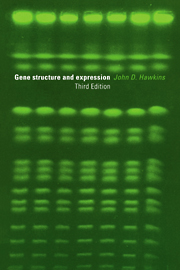Book contents
- Frontmatter
- Contents
- Introduction to the third edition
- Introduction to the second edition
- Introduction to the first edition
- List of abbreviations
- 1 Deoxyribonucleic acid (DNA)
- 2 Ribonucleic acid (RNA)
- 3 Methodology
- 4 Prokaryotic DNA replication and gene expression
- 5 The operon concept
- 6 Eukaryotic gene organisation and replication
- 7 Eukaryotic transcription
- 8 Post-transcriptional processing of RNA
- 9 Oncogenes
- 10 Haemoglobin
- 11 Proteins of the immune system
- 12 Some gene families
- 13 Mitochondrial and chloroplast genomes
- 14 Different and evolving genomes
- Glossary
- Reading lists
- Index
4 - Prokaryotic DNA replication and gene expression
Published online by Cambridge University Press: 05 June 2012
- Frontmatter
- Contents
- Introduction to the third edition
- Introduction to the second edition
- Introduction to the first edition
- List of abbreviations
- 1 Deoxyribonucleic acid (DNA)
- 2 Ribonucleic acid (RNA)
- 3 Methodology
- 4 Prokaryotic DNA replication and gene expression
- 5 The operon concept
- 6 Eukaryotic gene organisation and replication
- 7 Eukaryotic transcription
- 8 Post-transcriptional processing of RNA
- 9 Oncogenes
- 10 Haemoglobin
- 11 Proteins of the immune system
- 12 Some gene families
- 13 Mitochondrial and chloroplast genomes
- 14 Different and evolving genomes
- Glossary
- Reading lists
- Index
Summary
Prokaryotes have a single chromosome consisting of circular double-stranded DNA. The size may vary considerably, e.g. the E. coli chromosome contains about 3.8×106 bp, while that of Bacillus subtilis has 2×106 bp and that of Salmonella typhimurum has 10.5×106 bp. If the E. coli chromosome were in a linear extended form it would be about 1 mm long, but it is a fairly compact structure due to supercoiling of the DNA. This must be opened up to allow access for enzymes involved in replication or transcription in complex processes requiring several proteins, including helicases that relax supercoiled DNA, and single-strand binding protein (SSBP) (Chapter 1.3). Other proteins that are involved in these processes were originally identified by genetic means and are named after the genes that encode them (e.g. dnaB, dnaC, for the genes; DnaB, DnaC for the proteins).
Replication
This has been studied in simplified systems with the DNA from phages like ϕX174 and the plasmid pBR 322 that have specific replication origins. A multisubunit complex of primase (Pri) proteins is built up on these sites, known as primosome assembly sites. PriA binds to a single-stranded hairpin structure and acts as a 3′ → 5′ helicase, translocating along double-stranded DNA with the concomitant hydrolysis of ATP, and PriB is bound to this complex.
- Type
- Chapter
- Information
- Gene Structure and Expression , pp. 58 - 69Publisher: Cambridge University PressPrint publication year: 1996



